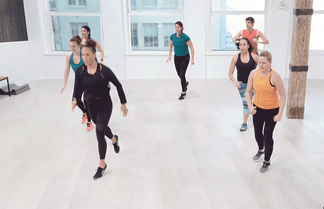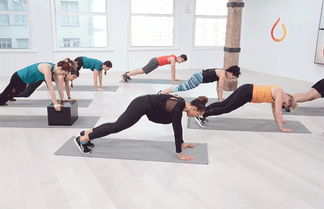A 10-minute cardio workout you can do at home

Plyometric moves rev your heart rate to the aerobic zone — burning major calories in a shorter time frame.Daily Burn
The secret to boosting your burn even more: compound exercises that work multiple muscles at once. Not only do the five moves below from Daily Burn 365 test your brain power, they’ll keep your metabolism revving even after you’re done. Plus, they’ll keep the workout fun so time flies. Before you know it, you’ll have cruised through 10 to 20 minutes of work, without even thinking of another excuse to stay in your seat. Step one: Stand up. It’s go time!
The Best Cardio Workout You Can Do in Your Living Room
Make sure you have enough room to jump front-to-back and side-to-side as this workout has you moving in all directions. Start with a light jog in place to shake out any stiffness, then tackle the five exercises below. Perform each one for 30 to 60 seconds, with no more than 15 seconds rest in between. Take a full minute to recover at the end of round one, then repeat at least once. It might be easier than climbing a mountain, but this cardio workout should still take your breath away.
1. Jump Rope Sky-to-Floor Reach
How to: Start standing with feet a little closer than hip-width apart, arms down by your sides (a). Begin swinging your forearms in a circle, as you would while holding a jump rope, as you jog your feet, kicking your heels toward your butt (b). Jog for six steps while swinging your invisible rope (c). Then, reach your arms straight up into the air, coming up onto your toes for a calf raise (d). Then reach down to the floor, bending at the knees for a narrow squat (e). Repeat another sky-to-floor reach (d). Continue alternating between six rope jumps and two sky-to-floor reaches.
2. Pop Squat
How to: Start standing with feet hip-width apart (a). Drop down into a squat, pushing your hips back and your butt down, with weight in your heels. Get low enough to touch the floor with one hand (b). Jump back up, bringing your feet together at the top (c). Then pop your feet back out to a squat, touching the ground with your other hand (d). Repeat.
3. Grape Vine Hip Twist
How to: Stand facing forward and take one step to the right with your right foot. Then, step your left foot behind your right. Next, step your right foot out to the right again and tap your left foot to your right. This is one grape vine (a). From here, bring your arms up to shoulder height, elbows bent so arms are parallel to the floor. With your feet together, jump and twist your hips to the right, then the left, repeating two times to each side (b). Then, repeat the grape vine to the left (c). Continue alternating between grape vines and four hip twists.
4. Lunge to Double Hop
How to: Start standing, facing forward. Step back into a lunge on your right foot. Knees should each bend 90 degrees and back right knee should hover just above the floor (a). Step back up to stand (b). Repeat the lunge on your left leg (c). Then take two hops at the top (d). Continue alternating lunges and double hops. If you need more of a challenge, make your lunge switch explosive, turning it into a plyometric exercise.
Comments
Post a Comment